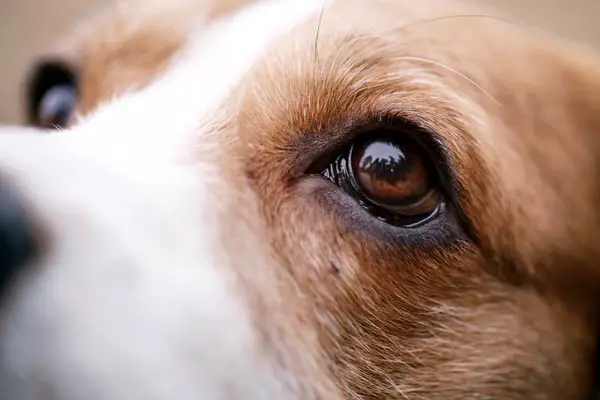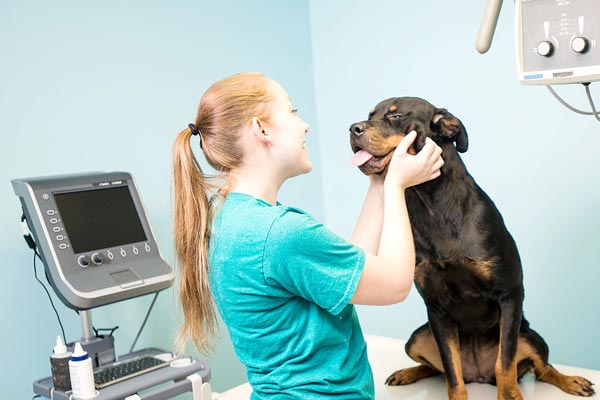Signs a Female Dog Has Mated: How to Tell If Your Dog is Pregnant
Female dogs can experience physical changes after mating, and dog owners must know these signs. Some physical symptoms of mating in female dogs include agitation, nervousness, and aggressiveness.
These behaviors can be regular communication from the dog, but owners must monitor their dog’s behavior and seek veterinary care if necessary.
One of the female dogs’ first physical signs of mating is vulvar swelling, which can occur before vaginal bleeding. Some female dogs may experience heavy bleeding during estrus, while others may have minimal bleeding. Another sign to look out for is damp, matted hair on the female dog’s head and facial area, along the back down to the tail.
As the fertilized eggs become embryos within the uterus, the female dog’s personality may change subtly. She may become more affectionate, less energetic, or show signs of nesting by keeping her toys in order and close.
If a female dog has mated, she may become standoffish and lethargic around the male and even walk funnily due to discomfort. Understanding these signs can help dog owners provide proper care for their pets.
Signs a Female Dog Has Mated
Specific physical and behavioral changes may occur when a female dog mates with a male. These changes can help you determine if your dog has successfully mated.
Witnessing the Mating Act
One of the most obvious signs that your female dog has mated is if you have witnessed the mating act. However, this is not always the case; some dogs may mate when their owners are absent.
Changes in Behavior After Mating
After mating, some female dogs may become more affectionate and clingy towards their owners. Others may become more withdrawn or irritable. These changes in behavior can be attributed to hormonal fluctuations and should subside within a few days.
Physical Signs
Physical signs your female dog has mated include a swollen vulva, bloody discharge, and frequent urination. These signs may last several weeks, and monitoring your dog’s behavior during this time is essential.
Appetite Changes
Some female dogs may experience changes in their appetite after mating. They may become more hungry or lose interest in food altogether. These changes are regular and should not cause concern unless they persist for an extended period.
Tiredness or Lethargy
Female dogs may also experience tiredness or lethargy after mating. This occurs as a result of hormonal changes that occur during the mating process. Allowing your dog to rest and recover during this time is essential.
Veterinary Monitoring
If you suspect that your female dog has mated, it is important to consult with a veterinarian. A veterinarian can perform a vaginal smear or serum progesterone test to determine if your dog is pregnant. They can also monitor your dog’s health throughout gestation and guide you in caring for a pregnant dog.
There are several signs that your female dog has mated. These signs include physical changes, changes in behavior, and appetite changes. If you suspect your dog has bred, monitor their behavior and consult a veterinarian.
Understanding the Heat Cycle
The heat cycle, also known as the estrus cycle, is a recurring reproductive cycle that female dogs experience. It determines when a dog can enter heat or become pregnant if she mates with a male dog. Understanding the heat cycle is essential for dog owners who want to breed their dogs or prevent unwanted pregnancies.
Stages of the Heat Cycle
The heat cycle has four stages: proestrus, estrus, diestrus, and anestrus. The female dog’s body prepares for mating during proestrus, and the vulva swells.
Estrus is the mating phase characterized by the female dog’s willingness to mate. During diestrus, the female dog’s body prepares for pregnancy; if she does not become pregnant, the cycle ends with anestrus.
Frequency and Duration of Heat Cycles
The frequency and duration of heat cycles vary between breeds and individual dogs. Smaller breeds, such as the Basenji, tend to have more frequent heat cycles, while sled dog breeds may only have one cycle per year. The heat cycle usually lasts 2-4 weeks, with the estrus phase lasting around nine days.
Physical and Behavioral Signs of a Dog in Heat
Physical signs of a dog in heat include a swollen vulva, a bloody discharge from the vagina, and increased urination. Behavioral symptoms include restlessness, increased vocalization, and a willingness to mate with male dogs. It is vital to keep female dogs in heat away from male dogs to prevent unwanted pregnancies.
Hormones and the Estrus Cycle
Hormones, including estrogen and progesterone, control the estrus cycle. These hormones cause the physical and behavioral changes associated with the heat cycle. Female dogs reach puberty at around six months of age, and their first heat cycle usually occurs between six and twelve months.
Understanding the heat cycle is crucial for dog owners who want to breed their dogs or prevent unwanted pregnancies. The heat cycle consists of four stages, with physical and behavioral signs indicating when a female dog is in heat. For most female dogs, the estrus cycle, regulated by hormones, typically occurs between six and twelve months.
Mating and Conception Process
During a female dog’s heat cycle, there is an optimal time for mating to occur. Most dogs ovulate and become receptive around the eleventh day of estrus. Figuring out the exact time of ovulation might not be easy, so it’s important to watch the female dog’s behavior and physical signs closely.
Mating attempts should be made during the receptive period to increase the chances of successful conception. The male and female should be allowed to mate naturally, and a copulatory tie may occur.
The tie is when the male’s penis swells inside the female’s vagina, and they are stuck together for several minutes to an hour. This is a normal part of mating and helps ensure successful mating.
It is essential to monitor the mating process to ensure success. Factors such as age, breed, and health can affect conception rates. If the mating is successful, the female may become impregnated, and embryos will begin to develop.
Around 20 to 28 days after mating, an x-ray or ultrasound can be performed to confirm pregnancy and the number of fetuses. The embryos’ heartbeats can be detected, and the veterinarian can determine if there are any complications or issues.
False pregnancy can occur in female dogs, where they exhibit symptoms similar to pregnancy, such as nesting behavior, lactation, and enlarged genitalia. However, they are not pregnant. It is essential to distinguish between a false pregnancy and a real one to provide proper care for the female.
Post-coital discomfort is common in female dogs after mating and can include lethargy, loss of appetite, and mild cramping. Providing the female with a comfortable and quiet environment to rest and recover after mating is essential.
Overall, monitoring the mating process and ensuring success is crucial for a healthy pregnancy and litter.
Confirming Pregnancy in Dogs
Confirming pregnancy in dogs is essential for pet owners who have bred their dogs or suspect that their female dog has mated. Here are some ways to confirm pregnancy in dogs:
Physical and Behavioral Signs of Pregnancy
One of the earliest signs of pregnancy in dogs is a change in nipple color and size. The nipples become rosier and more prominent, usually around two to three weeks after mating. Other physical signs of pregnancy include weight gain, decreased appetite, and lethargy.
Behavioral changes may also indicate pregnancy. A pregnant dog may become more affectionate or protective of her owner, while others may become more withdrawn or irritable.
Timeline for Confirming Pregnancy
Dogs usually have a pregnancy that lasts about 63 days, but it can sometimes be a bit shorter or longer. It is best to confirm pregnancy around the 28th day after mating, as this is when a veterinarian can detect fetal heartbeats.
Pregnancy Detection Methods
There are several methods for detecting pregnancy in dogs, including:
- Serum progesterone test: This blood test measures the progesterone level in the dog’s blood, which increases during pregnancy.
- Ultrasound: This non-invasive imaging technique can detect fetal heartbeats and confirm pregnancy.
- X-rays can confirm pregnancy and estimate litter size, but they should only be performed after day 45 of gestation to avoid harming the developing puppies.
Veterinary Care
It is essential to seek veterinary care to confirm pregnancy and monitor the pregnant dog’s and developing puppies’ health. A vet can do the important tests and help with the right food, exercise, and care when a dog is pregnant.
Confirming dog pregnancy is crucial for pet owners who have bred their dogs or suspect their female dog has mated. Physical and behavioral signs, veterinary care, and pregnancy detection methods can help confirm pregnancy and ensure the health of the pregnant dog and developing puppies.
Caring for a Pregnant Dog
When a female dog becomes pregnant, it is essential to provide proper care to ensure a healthy pregnancy and birth. Here are some critical considerations for caring for a pregnant dog:
Proper Nutrition and Feeding
During pregnancy, a dog’s nutritional needs increase. Providing a balanced diet that includes high-quality protein, vitamins, and minerals is crucial. A veterinarian can recommend a suitable diet and supplements if needed. Monitoring the dog’s weight gain and adjusting the diet is also essential.
Exercise and Activity Levels
Moderate exercise benefits pregnant dogs, but avoiding overexertion or strenuous activities is essential. Short walks and gentle playtime are ideal, but it is crucial to consult with a veterinarian before starting any exercise routine.
Preparing for the Birth
Preparing a comfortable and safe area for the dog to give birth is essential. This can include a whelping box with clean bedding and a heat source. It is also crucial to have supplies, such as towels, scissors, and clamps.
Veterinary Care During Pregnancy
Regular veterinary checkups are crucial during pregnancy to monitor the dog’s health and ensure safe delivery. A veterinarian can perform ultrasounds to monitor the pregnancy’s progress, check for any infections, and perform a progesterone test to determine the optimal time for delivery.
Other Considerations
Monitoring the dog for any signs of complications, such as excessive bleeding or infection, is essential. False pregnancy can also occur, so monitoring the dog’s behavior and avoiding excessive licking of the rear end is crucial. It is also necessary to consider the dog’s reproductive cycle and take steps to prevent unwanted puppies.
Caring for a pregnant dog requires proper nutrition, exercise, and veterinary care. These steps can help ensure your furry friend’s healthy pregnancy and birth.
Conclusion
Recognizing the signs of mating in female dogs is crucial for their safety and well-being. Understanding dog pregnancy and breeding practices to prevent unwanted litters and ensure responsible pet ownership is also essential.
If a female dog has mated, it is recommended to consult a veterinarian for guidance and care. They can perform a physical examination, ultrasound, or blood test to confirm pregnancy and monitor the dog’s health throughout gestation.
Being a responsible pet owner means getting your pet spayed or neutered, which helps lower the number of puppies and kittens without homes in shelters. It is also essential to practice responsible breeding practices, such as ensuring both parents are healthy and free of genetic disorders.
Recognizing the signs of mating in female dogs is an important part of responsible pet ownership. Consultation with a veterinarian can provide guidance and care throughout the gestation period, and responsible breeding practices can help prevent unwanted litters and promote the health of the animals involved.







I really loved this article, it’s really helpful in dealing with our furry family and friend.